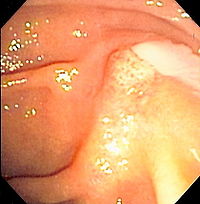
Photo from wikipedia
Secondary sclerosing cholangitis (SSC) is a term used for a group of chronic cholestatic disease affecting the intra- and/or extrahepatic biliary tree with inflammation and progressive stricture formation, which can… Click to show full abstract
Secondary sclerosing cholangitis (SSC) is a term used for a group of chronic cholestatic disease affecting the intra- and/or extrahepatic biliary tree with inflammation and progressive stricture formation, which can lead to biliary cirrhosis. A newly recognized form of SSC is secondary sclerosing cholangitis in critically ill patients (SSC-CIP). Pathogenesis is believed to involve ischemic injury of intrahepatic bile ducts associated with prolonged hypotension, vasopressors administration, and/or mechanical ventilation in patients treated in the intensive care unit (ICU). Patients diagnosed with SSC-CIP have no prior history of liver disease and no known pathologic process or injury responsible for bile duct obstruction prior to ICU treatment. Reasons leading to ICU treatment are many including multitrauma, burn injury, cardiac surgery, severe pneumonia, other infections, or bleeding after abdominal surgery. Patients have in common prolonged ICU admission. SSC-CIP is associated with rapid progression to liver cirrhosis and poor survival with limited treatment options except a liver transplantation. Transplant-free survival is around 17–40 months, which is lower than in other SSC patients. During the initial stages of the disease, the clinical symptoms and biochemical profile are not specific and easily missed. Biliary casts formation may be considered pathognomonic for SSC-CIP since most patients have them in early stages of the disease. Increased awareness and early detection of the disease and its complications is considered to be crucial to improve the poor prognosis.
Journal Title: Clinical and Experimental Gastroenterology
Year Published: 2017
Link to full text (if available)
Share on Social Media: Sign Up to like & get
recommendations!